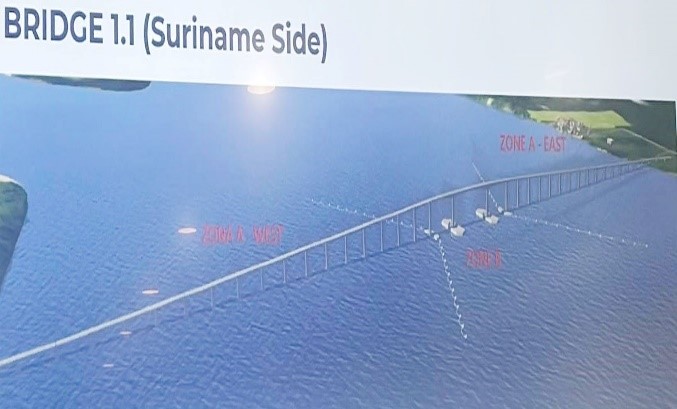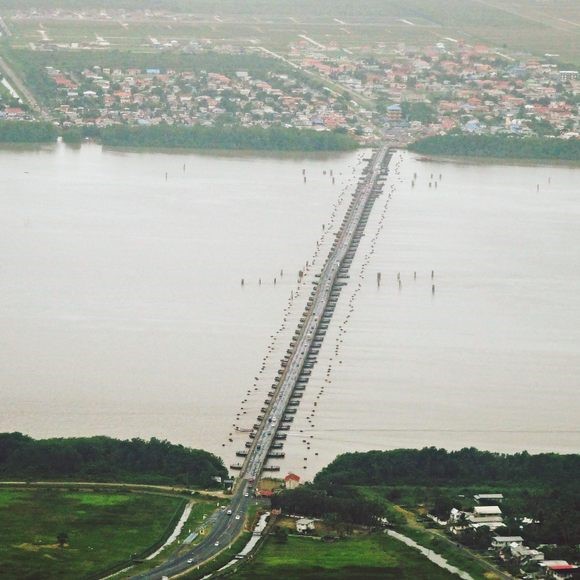Minister of Public Works Juan Edghill on Friday announced that developmental works for the four-lane bridge across the Demerara River in Wismar, Linden, Region Ten, are slated to begin this year.
This disclosure was made by the minister at his year-end press conference held at the Ministry of Public Works’ boardroom in Wight’s Lane, Kingston, Georgetown. He also remarked, “Monies have been provided, and the contractor was identified, so we are ready to go.”
Stabroek News understands that the company contracted for the project is China Railway Construction Corporation according to a project engineer at the Ministry of Public Works.
In 2020, an elevated precast concrete girder bridge equipped with two traffic lanes and a footpath was proposed to replace the existing Wismar Bridge, which has deteriorated over the years. However, the design was amended to accommodate four lanes of traffic.
The design of the bridge was unveiled by Italy-based engineering firm – Politecnica Ingegneria ed Architettura Società Cooperativa – which was contracted by the Ministry of Public Infrastructure to conduct a feasibility study and prepare detailed designs for the construction.
Assistant Project Manager, Francisco Reina, explained that from the feasibility study, they were able to generate four different designs for the new bridge. However, he opined that the best option was the precast concrete girder bridge, which is similar to the design of the existing bridge.

He informed that this bridge features a mid-range elevation with five spans at 44 metres each. It is structurally recommended and will be constructed to accommodate all types of vehicles in Guyana.
The new location of the bridge over the Demerara River is proposed to be in proximity to the existing bridge. In the design, it was also proposed that roundabouts be constructed at both ends of the bridge to accommodate an easy flow of traffic and have multi-thoroughfare access.
Reina explained that the design for the bridge was developed after several criteria were considered. Before arriving at the design, a traffic impact study was carried out to cater for the volume of traffic extrapolated 20 years into the future.
The bridge carries a minimum lifespan of 50 years with limited maintenance. However, with an effective maintenance programme in place, the bridge can last longer. The mid-range of the bridge will be elevated to 11 metres.
Back in June of this year, Vice President Bharrat Jagdeo had revealed that the bridge is pegged to cost some US$35 million.
“We are at a stage where we are ready to start the negotiations. We have had three offers and when the details emerge you will see the offers we received were very competitive…” he had told reporters.
He pointed out that the negotiations on behalf of the government were to be done by the team comprising Sukrishnalall Pasha (Finance Secretary), Ronald Burch-Smith (Attorney), Teni Housty (Attorney), and Marcel Gaskin (Consultant/Engineer). This is the same team that negotiated for the new Demerara Harbour Bridge and China Railway Construction Corporation Limited is the same company that was awarded the contract for the construction of that bridge.
Vice President Jagdeo announced the plans for the new bridge earlier this year, during an outreach in Linden. The bridge is being funded under a US$200 million financial agreement with the Islamic Development Bank (IsDB).
Public Works Minister Juan Edghill also told Stabroek News a few months ago that the sum was increased from US$120 million to US$200 million to cater for the construction of the bridge.
That sum will also cover the reconstruction of the 73-kilometre-long, two-lane Soesdyke-Linden Highway, which runs between Soesdyke and Linden in Guyana and other infrastructural projects.
Corentyne River Bridge
Meanwhile, Edghill at the year-end press briefing on Friday added that the evaluation of bids for the construction of the Corentyne River Bridge has been completed.
A joint executive decision on modality and financing is being examined by the governments of Guyana and Suriname, which include ministers from the ministries of Foreign Affairs, Finance, and Public Works, Edghill informed.
“Once that evaluation report would have been agreed and the way forward declared by that joint team, the two presidents would then announce the start of the work on the Corentyne River Bridge,” he said.
Stabroek News in June reported that Trinidad-based consultants, WSP Caribbean, had designed and proposed a two-section bridge connected by an island in the Corentyne River to link Guyana and Suriname.
The cost of the bridge along with other reports on the traffic projections/forecasts, financial and economic evaluation, environmental assessment, legal framework, and the design of the roads, among other technical aspects, are yet to be finalised.
WSP in explaining the design, had said that the bridge will feature two lanes and will be able to accommodate a third in cases of emergencies or controlled conditions.
The bridge superstructure will have a total deck width of 12.4 metres including lanes and shoulders with the carriageway measuring 10.05 metres. It will also have utilities inside the box girder with an internal inspection path width, an on-top inspection path; wearing surface: and extra concrete thickness, milled after closure. The bridge will also feature a steel railing along with solar-powered luminaires at the deck slab edge, next to the deck inspection path, the WSP Caribbean representative stated.
From Guyana’s end, the bridge will be 1,100 metres with 22 spans, each measuring 50 metres in length while at Suriname’s end, it will feature an elevated section.
That section of the bridge will comprise two zones. Zone ‘A’ East, it was explain-ed, will consist of 20 spans at 1,000 metres and Zone ‘A’ West with 19 spans at 950 metres.
The WSB representative indicated that Zone ‘B’ which is referred to as the Main Bridge, will consist of 80 to 130-metre spans. Further, they noted that all the main bridge’s piers are protected against ship impact and piers in the access bridges are protected by guiding monopile dolphins connected through tethered floating fenders.
The Corentyne River Bridge will be constructed via a Public Private Partner-ship (PPP) arrangement and according to the Design-Build-Finance-Operate-Maintain model (DBFOM). This means that the successful contractor of the joint venture will be responsible for its final design, construction, financing, operation, and maintenance.
The list of pre-qualified contractors/ joint ventures are China Road and Bridge Corporation (CRBC); China Railway Construction International Ltd (CRCCI), China Railway Construction Caribbean Co Ltd, and China Railway Construction Bridge Engineering Bureau Group Co Ltd (CRBG); Ballast Nedam Infra Suriname B.V.; China Harbour Engineering Company (CHEC); and China Overseas Engineering Group Co Ltd (COVEC), China Railway Eryuan Engineering Group Co Ltd (CREEC), and China Railway First Group (CRRG).
In May last year, a US$2 million agreement was inked with WSP Caribbean Limited for the Feasibility Study and Design for the Bridge over the Corentyne River.






